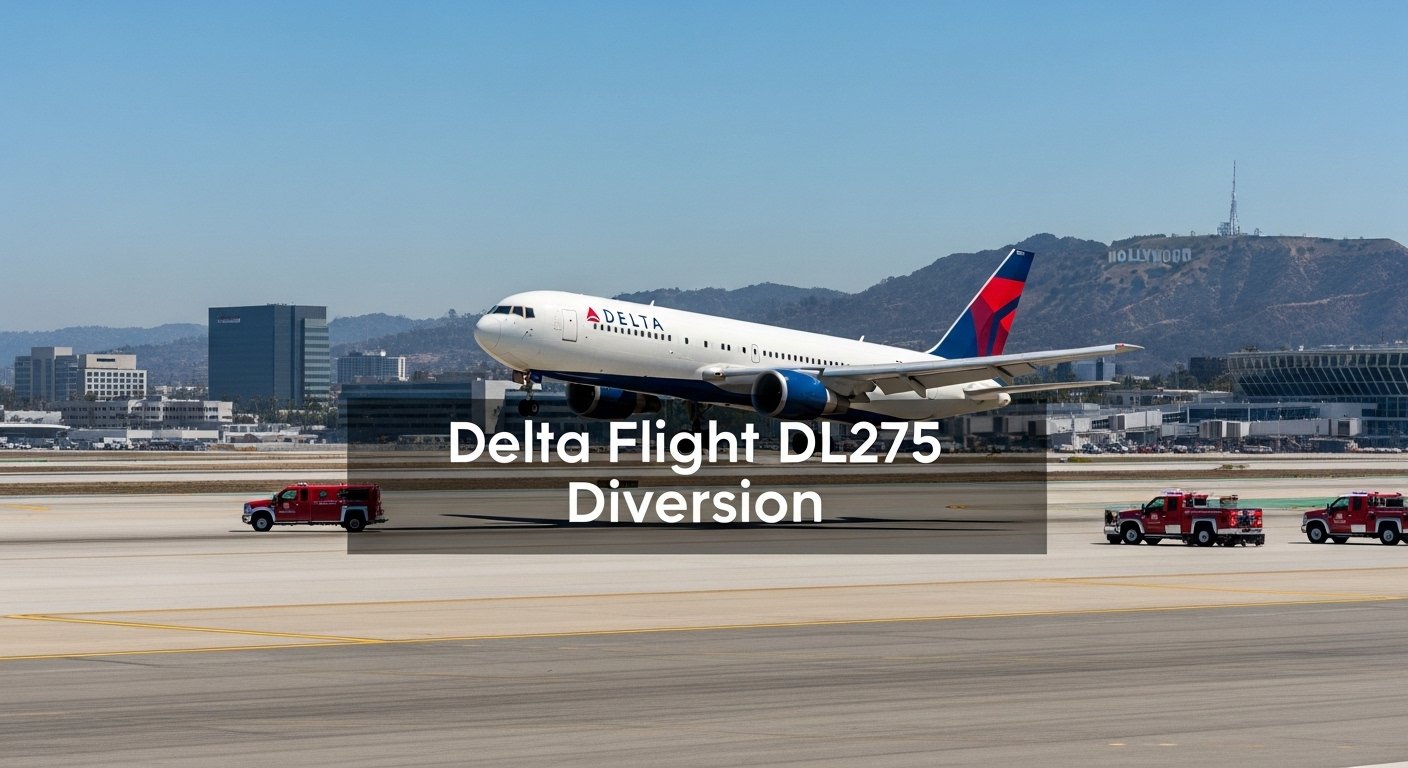Have you ever wondered what goes on behind the scenes when a flight suddenly changes course? In the world of aviation, diversions aren’t uncommon, but they can spark a lot of questions and concerns. Take Delta Flight DL275, for instance—a routine international journey that took an unexpected turn and was diverted to LAX (Los Angeles International Airport). This incident, which occurred on a flight originating from Paris Charles de Gaulle (CDG) en route to Seattle-Tacoma International Airport (SEA), highlights the unpredictable nature of air travel.
In this article, we’ll dive deep into the details of the delta flight dl275 diverted lax event. We’ll explore the timeline, possible reasons, how it affected passengers, Delta’s official response, and even tips for handling similar situations. Whether you’re a frequent flyer or just curious about aviation news, understanding these events can make you a more informed traveler. Let’s break it down step by step.
The Timeline of Delta Flight DL275’s Diversion to LAX
Flight diversions can happen in the blink of an eye, but piecing together the sequence of events helps us understand the bigger picture. For Delta Flight DL275, the story unfolded on a chilly January morning in 2023, though similar incidents have occurred on this route before.
The flight departed from Paris CDG around 10:30 AM local time, carrying over 200 passengers and crew members aboard a Boeing 767-300ER. Everything seemed normal during the initial climb over the Atlantic. However, about six hours into the journey—somewhere over the Midwest U.S.—the pilots reported an issue that prompted a precautionary decision.
According to flight tracking data from sites like FlightAware and ADS-B Exchange, the aircraft began descending and altered its course southward. By 2:00 PM Pacific Time, Delta Flight DL275 was on final approach to LAX Runway 25L. Emergency vehicles were on standby, but the landing was smooth and without incident. Passengers disembarked normally, though many were left wondering: Why LAX, of all places?
This wasn’t the first time DL275 faced disruptions. Historical data shows occasional reroutes on this transatlantic path due to weather or technical glitches. In this case, the diversion added about 400 extra miles to the journey, turning a 10-hour flight into a multi-day ordeal for some.
Key Moments in the Diversion
To make it clearer, let’s outline the key timestamps:
- Departure: 10:30 AM CET from CDG, with clear skies and no initial warnings.
- Mid-Flight Alert: Around 4:00 PM CET (8:00 AM PT), crew notices an anomaly—details later confirmed as non-critical but warranting caution.
- Diversion Decision: Pilots coordinate with air traffic control (ATC) and Delta operations center in Atlanta.
- Arrival at LAX: 2:15 PM PT, met by ground crew for inspections.
Imagine being a passenger mid-movie when the captain announces, “Folks, we’re heading to LAX instead.” It’s moments like these that test an airline’s preparedness.
Explore More Topic: 5StarsStocks.com
Why Was Delta Flight DL275 Diverted to LAX?
Diversions aren’t random—they’re driven by safety protocols designed to protect everyone on board. In the case of delta flight dl275 diverted lax, the primary reason boiled down to a suspected mechanical issue, though Delta hasn’t released full technical details to protect ongoing investigations.
From aviation reports and insider accounts, the issue involved the aircraft’s hydraulic system—a critical component for controlling flaps, landing gear, and brakes. While not an emergency in the dramatic sense (no “mayday” call was issued), pilots followed FAA guidelines to divert to the nearest suitable airport with ample resources. LAX, with its long runways, advanced maintenance facilities, and proximity to Delta’s West Coast hubs, was the logical choice over continuing to SEA.
But why not another airport? Questions like this often arise. For example, Salt Lake City (SLC) or San Francisco (SFO) could have been options, but factors like fuel levels, weather (clear at LAX that day), and runway availability tipped the scales. Aviation experts note that diversions to major hubs like LAX minimize delays for repairs and rebooking.
Common Reasons for Flight Diversions in General
To put this in context, let’s look at broader trends. According to the National Transportation Safety Board (NTSB), about 1 in 1,000 commercial flights in the U.S. experiences a diversion. Common culprits include:
- Mechanical Problems: Like the suspected hydraulic glitch on DL275—think engine vibrations or electrical faults.
- Medical Emergencies: A passenger illness could prompt a quick landing.
- Weather Issues: Turbulence or storms, though not a factor here.
- Security Concerns: Rare, but always a possibility.
In DL275’s case, it was a classic precautionary mechanical diversion. Delta Airlines emphasizes that safety is non-negotiable, and this event underscores that philosophy. Have you ever experienced a diversion? It’s a reminder that pilots train rigorously for these scenarios.
Impact on Passengers and Crew During the Delta Flight DL275 Diversion
No one books a flight expecting detours, but when they happen, the human element comes into play. For the passengers on delta flight dl275 diverted lax, the experience ranged from mild inconvenience to significant frustration.
Many travelers were en route to Seattle for business meetings, family reunions, or vacations. Upon landing at LAX, Delta provided immediate assistance: hotel vouchers for overnight stays, meal credits, and rebooking on the next available flight to SEA (which departed the following morning after repairs). One passenger shared on Reddit: “It was chaotic at first, but Delta reps were everywhere helping. I got a free night at a nice hotel near LAX.”
Crew members, too, faced extended duties. Pilots and flight attendants had to manage anxious passengers while adhering to rest regulations under FAA rules. No injuries were reported, which is a testament to the smooth handling.
Emotional and Practical Effects
Emotionally, diversions can be stressful. Imagine a family with young kids suddenly in an unfamiliar airport—questions like “When do we get home?” flood in. Practically, it meant lost time: Some missed connections, leading to compensation claims under Delta’s policies (up to $700 per passenger for delays over three hours).
On the positive side, this incident highlighted passenger safety protocols. Evacuation drills aren’t just routine; they’re lifesavers in real scenarios. Delta’s app allowed real-time updates, easing some worries.
Delta Airlines’ Official Response and Statements
How an airline responds to incidents like this speaks volumes about their commitment to transparency and customer care. In the wake of delta flight dl275 diverted lax, Delta issued a statement within hours via their News Hub and social media channels.
“Delta Flight DL275 from Paris to Seattle was safely diverted to Los Angeles due to a potential mechanical indication,” read the official release. “The aircraft landed without incident, and all passengers and crew are safe. We apologize for the inconvenience and are working to get everyone to their destinations as quickly as possible.”
Delta’s CEO, Ed Bastian, has often emphasized safety in public addresses, and this event aligned with that. The airline conducted a thorough inspection at LAX’s maintenance hangar, replacing parts before clearing the plane for service. Compensation was proactive: Affected passengers received SkyMiles bonuses and refunds where applicable.
Lessons Learned and Improvements
Post-incident, Delta reviewed procedures, as they do with all diversions. This might include enhanced pre-flight checks on Boeing 767 fleets. Industry watchers praise Delta for their low diversion rate—about 0.5% of flights—compared to competitors.
If you’re flying Delta soon, check their app for status alerts. It’s a simple step that could save headaches.
Similar Aviation Incidents: Learning from Delta Flight DL275
The delta flight dl275 diverted lax isn’t isolated. Aviation history is dotted with similar stories that teach valuable lessons.
For instance, in 2019, a Delta flight from Atlanta to London diverted to Boston due to engine issues, much like DL275’s mechanical concern. Or consider United Flight 328 in 2021, which scattered debris over Denver after an engine failure but landed safely—emphasizing emergency landing preparedness.
Globally, diversions spike during peak seasons. A 2022 report from the International Air Transport Association (IATA) noted over 5,000 diversions worldwide, with mechanical issues accounting for 40%. LAX, as a diversion hotspot, handles dozens monthly thanks to its infrastructure.
What can we learn? Always pack essentials in carry-ons, download airline apps, and know your rights under regulations like EU261 for international flights.
Comparing to Other Delta Diversions
Delta’s track record is strong. Another example: DL Flight 89 in 2020 dumped fuel over LAX en route to Shanghai due to an engine problem, drawing scrutiny but no injuries. Unlike that, DL275’s diversion was low-drama, focusing on rerouting efficiency.
These comparisons show that while diversions disrupt, they’re safer than pushing through risks.
How to Check Flight Status and Handle Diversions Like Delta Flight DL275
Preparation is key in air travel. If you’re worried about something like delta flight dl275 diverted lax happening to you, here’s practical advice.
First, monitor flight status via tools like FlightRadar24 or Delta’s website. Enter your flight number (e.g., DL275) for real-time tracking. Apps send push notifications for changes.
If diverted:
- Stay Calm: Listen to crew instructions.
- Know Your Rights: U.S. DOT rules mandate rebooking and compensation for controllable delays.
- Contact Support: Use Delta’s helpline (1-800-221-1212) or chat feature.
- Travel Insurance: It covers extras like hotels.
Example: A traveler on a similar diverted flight used points to book a lounge at LAX, turning wait time into relaxation.
By staying informed, you turn potential chaos into manageable hiccups.
Conclusion: Safety First in the Skies
The story of delta flight dl275 diverted lax reminds us that air travel, while remarkably safe, isn’t immune to surprises. From the mechanical trigger to the seamless landing at LAX, this incident showcased Delta’s prioritizing of passenger safety above all. No one was hurt, and most passengers reached Seattle with minimal long-term disruption.
As aviation evolves with better tech and protocols, events like this become learning opportunities. Whether you’re planning a trip or reflecting on past flights, remember: Diversions are rare, but preparedness makes all the difference. Fly safe, and always check those updates. If you’ve got a diversion story, share it in the comments—let’s keep the conversation going!
Explore More Topic: Anonposted
FAQ
What caused Delta Flight DL275 to be diverted to LAX?
The diversion was due to a suspected mechanical issue with the aircraft’s hydraulic system. Delta Airlines confirmed it was a precautionary measure, and the plane landed safely at LAX for inspections and repairs.
Were passengers on Delta Flight DL275 compensated after the diversion?
Yes, affected passengers received hotel vouchers, meal credits, rebooking assistance, and potential refunds or SkyMiles. Compensation follows Delta’s policies and U.S. DOT guidelines for delays.
How can I track if my Delta flight might be diverted?
Use Delta’s mobile app, website, or third-party trackers like FlightAware. Enable notifications for real-time updates on flight status, including potential diversions or delays.
Is LAX a common airport for flight diversions?
Yes, LAX’s long runways, maintenance facilities, and location make it a frequent diversion hub for West Coast and transatlantic flights. It handles numerous emergency landings and reroutes annually.

